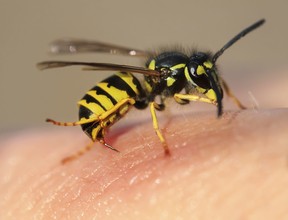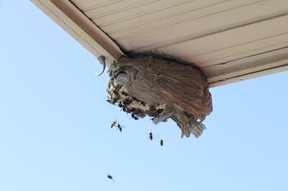
Reviews and recommendations are fair and product independent Has been selected. Postmedia may earn affiliate commissions from purchases from links on this page.
At the age of 11, I stepped on the Hornet. As the night approaches on a particularly hot day in the suburbs, the radio is BeatlesPaperback Writer, Beach BoysGood Vibration, DonovanSunshine SupermanHours ..
That was a long time ago.
And the pain of stepping on that Hornet flutters me to this day.
I'll cover this because my best friend was recently chased by saying he inadvertently stepped on the Hornet. She-with her dog-ran for their lives to escape the horrific attacks. This isn't the first time she's been stabbed, and she remembers once flocking.
"When I think of Hornet, the word anger comes to mind," she said ominously, adding, "they are one angry insect."
They are, but it's not their fault. They are only guarding their lawn. And despite the murder Hornets (yes, theWeather Networkis also known as the "murder Hornets", like members of the giant Hornets of Asia (Soplanos). (Masu) is reported — recently discovered in BC), a normal Hornet just wants to live in peace with everyone else.
Just don't step on them. Or touch their nest. Or say hello or anything.
But – what the hell is Hornet? They are large, threatening, the most common are yellow and black, and some species have reddish markings. And they confuse with a bee, the two being very similar, except that one colony is larger and the head is bigger than the other.

according to thecanadianencyclopedia.ca, Hornet is a Vespa bee. It is a popular name for. family. This includes other social bees such as yellow jackets and paper bees. "There are 22 hornets around the world," said the site. "Three introduced species have been discovered (in Canada). European hornets (Vespa crabro) in southern Ontario and Quebec, Japan. Yellow Hornet (Vespa simillima) and Giant Asian Hornet (Vespa mandarinia) on the British Columbia coast. "

The bald-faced Hornet is native to Canada, but is actually a yellow jacket wasp. I think many people are familiar with this, especially if they have stepped on it.
This site states that Hornet is a relatively social creature – in fact. Well, they are their own nest seeds, where they form a colony of overlapping generations and, according to the website, have their own cast system, including spawning queens and non-reproductive female workers. I am. male. They mate and proceed to the next queen.
Where do you hang out? According to Orkin Canada (orkincanada.ca), "In general, hornets are attracted to urban environments and other densely populated areas. Many species of hornets that nest in the air and on the ground Nests are built on or in man-made buildings and structures (and) often hang from wall gaps, rooftops, inside window frames, or from eaves. "
Hornet will set up colonies "in shrubs, underground, hollow trees, under the bark, in rocky mountains".
And what they eat may help you avoid them. According to Orkin Canada, adult hornets like to eat a variety of sweet liquids such as fruits, fruit juices and other pops. Hornet larvae "eat carcasses of animals, prepared pieces of meat, and pieces of cricket, butter, large flies, hairworms, and even soft-bodied insects such as other bees and Hornet workers." Sounds like a fun group.
How much do you need to worry about Hornet? Well, we all know that they have a triggering temperament and are inherently aggressive – but because they are very protective of their dwellings.
How deadly they can be. Those who have been stabbed know how painful they can be, especially if the stabs still remain on your skin. However, if you are allergic to a sting, it is very dangerous and can lead to anaphylactic shock if not treated immediately.
Did you know
The average person is bitten by insects less than 5 times in his life. Still, stings are the main reason we fear bees and try to hit them every time we see it.
– Fantasticpestcontrol.co.uk
How to handle sting
According to Healthline.com, "Hornet's bees and bees are equipped with stinger for self-defense. Wasp's stinger contains poison that is transmitted to humans when stabbed. However, if there is no stab wound. However, Wasp venom can cause serious pain and irritation. If you are allergic to the venom, you may have a serious reaction. In either case, rapid treatment is associated with the symptoms. It's the key to alleviating the illness. "
Clean the area with warm soap and water, apply a cold pack to reduce swelling, and sometimes include over-the-counter pain relief. .. The stings are fast and ferocious – but short.
If there is a "big local reaction" (the term Healthline.com is used to describe more prominent symptoms and can actually increase for several days. There are some extreme redness and swelling, including nausea and vomiting), which may be a sign that a person has an allergic reaction, but has not experienced life-threatening symptoms such as anaphylactic shock. In this case, please contact your doctor or see a doctor. Some people may be advised to take over-the-counter antihistamines. "Just because there is one big local reaction after one bee sting does not necessarily mean that it will respond to future stings as well," the site said.
That said, why make it an opportunity? Please take measures to avoid encounters in the first place.

From the newsroom to the noon inbox, Toronto Sun's latest headlines, stories, opinions and photos. By clicking the
Thank you for registering.
A welcome email will be sent. If you don't see it, check your junk folder.
Your Midday Sun's next issue will arrive in your inbox shortly.


